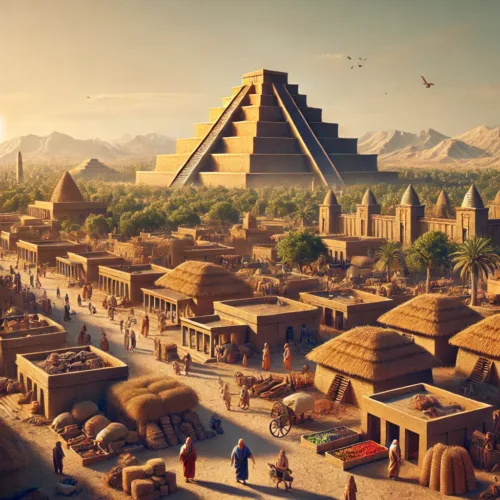The land of Ur is a significant place in biblical history, often credited as the birthplace of Abraham. Nestled in ancient Mesopotamia, Ur is a geographical reference but also a place that birthed the Judeo-Christian faith. In this deep dive, we will delve into the meaning and implications of Ur as detailed in the Bible. Ur shaped the trajectory of Abraham’s journey and, ultimately, the lineage of many cultures that emerged in its wake. The dictionary of the Bible offers some insights and helps us understand the meaning of Ur in the Bible and the significance of Ur in the Bible.
[Ur was a] great Sumerian metropolis, which was a real key in Mesopotamian commercial relations with the countries of the Persian Gulf and undoubtedly with the Indus Valley as well (Margueron).
Ur In The Dictionary of the Bible
Ur (of the Chaldeans)
Definition:
Ur was a major Sumerian city-state in ancient Mesopotamia, thought to be located in what is now southern Iraq near the Euphrates River. In the Bible, it’s referred to as “Ur of the Chaldeans” (Hebrew: ‘Ur Kasdim, אוּר כַּשְׂדִּים), especially in connection with the patriarch Abraham.
Biblical References:
- Genesis 11:28, 31 – Abraham’s family lived in Ur before migrating to Haran.
- Genesis 15:7 – God reminds Abraham He brought him out of Ur.
- Nehemiah 9:7 – Reaffirms God’s call of Abraham from Ur.
Historical Context:
- Ur was a wealthy and influential city, flourishing around 2100–2000 BC, during the time of the Third Dynasty of Ur.
- It was known for its ziggurat (temple tower) dedicated to the moon god Nanna (or Sin).
- Archaeological excavations (notably by Sir Leonard Woolley in the 1920s) uncovered advanced urban planning, trade, writing (cuneiform), and rich burial sites.
Religious Significance:
- Leaving Ur was a key moment in Abraham’s journey of faith. God called him to leave a prosperous, idolatrous city and go to a land he didn’t know.
- Some scholars believe this migration symbolises a move from paganism to covenant faith in the biblical narrative.
Historical Background of Ur
Ur appears to have first been settled by the early third millennium bc, although there is a possibility of earlier occupation. The buildings of the first dynasty at Ur, the earliest confirmed occupation, are not well preserved. However, there is evidence that a temple to the moon god, the patron god of Ur, existed in that period (Kennedy).
Ur resided within the thriving area of ancient Mesopotamia; the city of Ur was one of the most historically rich and significant sites of its day. Established around 3800 BCE, Ur thrived as a Sumerian city-state, playing a pivotal role in the early development of urban civilisation. In the biblical context, Ur is renowned as the birthplace of Abraham, one of the patriarchs of the Hebrew Bible, and his story begins with leaving this rich and vibrant land in Genesis 11:31. The city’s prominence during its heyday is reflected in its advanced architecture, economic power, and religious significance.
Ur was situated near the mouth of the Euphrates River, providing it with advantages in trade and agriculture. The city’s economy was bolstered by its connection to extensive trade networks that spanned the ancient world, facilitating the exchange of goods, ideas, and cultural practices (Shepherd). This connectivity not only enriched Ur economically but also made it a cultural crossroads where diverse influences met. The urban planning and architecture of Ur, including the famous Great Ziggurat dedicated to the moon god Nanna, made it notable in the same way we might think of modern-day wonders.
The historical context of Ur also encompasses its political dynamics and interactions with neighbouring city-states and empires. Over the centuries, Ur witnessed periods of prosperity and decline, influenced by shifts in power and external invasions. The rise and fall of dynasties, such as the Third Dynasty of Ur, which saw the city reach its peak around 2100 BCE, show that it was impacted by the rise and fall of powers like any other city. When we think of Abraham (then known at the point of Genesis 11 as Abram) leaving Ur, he did not do so lightly. It would have, perhaps, been a difficult choice.
Ur’s Significance in Biblical Narratives
In the biblical narrative, Ur’s significance is primarily anchored in its association with Abraham, one of the most pivotal figures in the Bible. It’s only mentioned 4 times and tells us very little about Abraham. Most of what we know is gleaned from understanding archaeology, which helps us build a picture of the place where Abraham grew up. In Genesis 11, Abraham was called by God to leave his homeland of Ur and journey to the land of Canaan, which would become the Promised Land for his grandchildren 11 generations later. This divine call and Abraham’s leaving of Ur mark the beginning of a covenantal relationship between God and the Israelites, making Ur the starting point of a different understanding of God.
Through learning more about the history of Ur, we learn that Abraham’s departure symbolises a leap of faith and obedience to God’s will, setting a precedent for the faith journeys of his descendants. They live in a prosperous and reputable city in the unknown, and all Abraham has to go on is a promise from God. This act of leaving behind the familiar for the unknown, guided by divine promise, is a recurring theme in the Bible and shows us the pattern of trust and obedience to God. Ur carries significant meaning for how we read the Bible; it represents the beginning of a transformative journey that shapes the identity and destiny of the Israelite people.
Ur’s significance also extends to its role in shaping the early life of Abraham. The cultural and religious background of Ur, with its advanced civilisation and polytheistic practices, provides a backdrop for understanding Abraham’s following of ‘one God’ (Franzmann). The difference between the many gods of Ur and the following of one God that Abraham embraced highlights the radical nature of his faith and the distinctiveness of the covenantal relationship he established with God. There is a statement in Abraham leaving to pursue space to establish the authority of God in his life and the life of his people as distinct from the land of Ur.
Archaeological Discoveries in Ur
The archaeological excavations at Ur unearthed many artefacts and structures that vividly depict life in this ancient city. One of the most significant discoveries is the Great Ziggurat of Ur, a massive terraced structure dedicated to the moon god Nanna. This imposing monument, built during the Third Dynasty of Ur around 2100 BCE, exemplifies the architectural and engineering prowess of the Sumerians. The ziggurat’s well-preserved remains offer insights into the religious practices and socio-political organisation of the time, reflecting the city’s importance as a spiritual centre.
In addition to the ziggurat, archaeologists have uncovered numerous residential and administrative buildings, revealing the city’s complex urban layout and sophisticated infrastructure. The excavation of private homes, temples, and public spaces has provided a glimpse into the daily lives of Ur’s inhabitants, including their domestic activities, social structures, and economic transactions. Artefacts such as pottery, jewellery, and tools shed light on the craftsmanship and artistic expressions of the people of Ur, while cuneiform tablets offer a wealth of information on their language, literature, and administrative practices.
One of the most remarkable finds at Ur is the Royal Cemetery, which dates back to the Early Dynastic period (c. 2600-2400 BCE). The cemetery contains elaborate tombs of Ur’s elite, including Queen Puabi, whose burial chamber was filled with exquisite treasures, including gold and silver jewellery, musical instruments, and intricately carved objects. The discovery of these tombs provides valuable insights into ancient Ur’s burial customs, social hierarchy, and material culture. The wealth and craftsmanship evident in these graves underscore the city’s prosperity and its role as a cultural and economic hub in ancient Mesopotamia.
Theological Implications of Ur in Scripture
The city of Ur carries significant theological weight in the scriptures, due to its association with Abraham and the relationship he established with God. Abraham’s departure from Ur is a defining moment symbolising an act of faith and obedience. This event marks the beginning of a divine covenant that promises Abraham numerous descendants and the land of Canaan as their inheritance. This exodus of Ur lays the foundation for the Israelite identity and their understanding of God’s promises and faithfulness.
Symbolically, it also represents a departure from a life of polytheism and exclusively moves Abraham to worship of Yahweh. The journey from Ur to the Promised Land symbolises the spiritual journey from sin and idolatry to redemption and covenantal relationship with God. Abraham’s willingness to leave behind the familiar and venture into the unknown, guided by faith in God’s promises, serves as a model of trust and obedience for subsequent generations. This trust and obedience are a common biblical thread.
Ur’s role in the biblical narrative underscores the theme of divine election and calling. Abraham’s selection by God to be the progenitor of a chosen people highlights the concept of divine initiative and grace. Abraham’s call out of Ur emphasises that it is God who calls and empowers individuals to fulfil His purposes, regardless of their background or circumstances. This theme resonates throughout the scriptures, reinforcing the idea that God’s plans and purposes are accomplished through His chosen instruments, beginning with Abraham’s journey from Ur.
Cultural and Economic Aspects of Ur
Ur’s cultural and economic aspects reveal a city that was a religious and political centre and a vibrant hub of commerce and cultural exchange. The city’s strategic location near the Euphrates River facilitated trade with neighbouring regions, including the Indus Valley, the Persian Gulf, and the broader Mesopotamian area. This connectivity allowed Ur to thrive economically, with its markets bustling with traders exchanging goods such as textiles, metals, pottery, and agricultural produce. The wealth generated from trade contributed to the city’s prosperity and the development of its sophisticated urban infrastructure.
The cultural life of Ur was equally rich and diverse, reflecting its status as a cosmopolitan centre. The city’s inhabitants engaged in various artistic and intellectual pursuits, as evidenced by the artefacts and texts uncovered by archaeologists. The craftsmanship of Ur’s artisans, seen in their jewellery, pottery, and sculpture, demonstrates high skill and aesthetic sensibility. Literary and administrative texts, written on tablets, provide insights into the intellectual pursuits of the time, including law, literature, and science. The famous Sumerian King List, which records the reigns of ancient rulers, and the Epic of Gilgamesh, one of the earliest known literary works, are among the significant texts associated with Ur.
Religious practices played a central role in the cultural life of Ur, with the city’s temples and ziggurats serving as focal points for worship and community gatherings. The Great Ziggurat, dedicated to the moon god Nanna, was not only a religious monument but also a symbol of the city’s political and economic power. The rituals and festivals held in honour of the gods were integral to the social fabric of Ur, reinforcing communal bonds and cultural identity. Ur’s religious and cultural practices provide a backdrop for understanding the environment in which Abraham lived and the influences that shaped his early life before his journey towards monotheism.
Ur in Modern Biblical Scholarship
The findings at Ur have offered scholars valuable insights into the daily lives, religious practices, and social structures of ancient Mesopotamian societies, allowing for a more nuanced interpretation of the biblical texts. The artefacts and texts uncovered at Ur have also contributed to a broader understanding of the interactions between different cultures and the dissemination of ideas and practices across the ancient Near East.
One of the significant contributions of modern scholarship is the reevaluation of the historical and literary aspects of the biblical narratives associated with Ur. By examining the archaeological evidence and comparing it with the biblical accounts, scholars have been able to contextualise the stories of Abraham and his descendants within the broader historical framework of the ancient Near East. This interdisciplinary approach has led to a more comprehensive understanding of the complex interplay between history, culture, and theology in the biblical tradition. The findings at Ur have also sparked debates and discussions among scholars, leading to new interpretations and perspectives on the biblical texts.
The study of Ur in modern biblical scholarship continues, and the most valuable insights are found in cultural practices and lifestyles during the existence of Ur. They inform us about the place that Abraham left and, therefore, help frame the Biblical writings against cultural backgrounds. Often, rules and laws, and even conduct, happened as a reaction to be seen as different to the surrounding nations, and it just might be that further insight enriches our understanding of scripture.
Happy reading!
References
Franzmann, W.H. (1980) Bible history commentary: Old Testament. electronic ed. Milwaukee, WI: Wisconsin Evangelical Lutheran Synod, pp. 94–95.
Kennedy, T.M. (2016) “Ur,” The Lexham Bible Dictionary. Edited by J.D. Barry et al. Bellingham, WA: Lexham Press.
Margueron, J.-C. (1992) “Ur (Place),” The Anchor Yale Bible Dictionary. Edited by D.N. Freedman. Translated by S. Rosoff. New York: Doubleday.
Shepherd, T.J. (1880) The Westminster Bible Dictionary. Philadelphia: Presbyterian Board of Publication.










